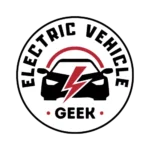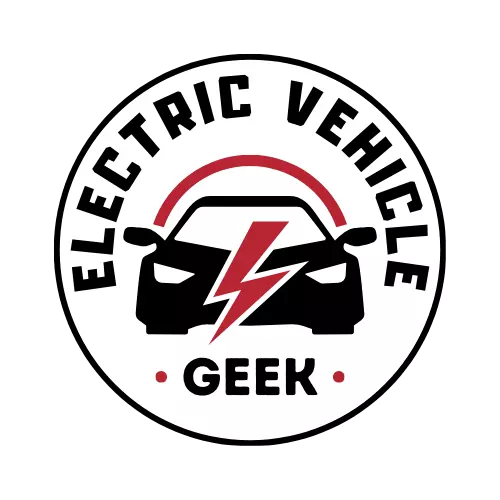Supported by you via insider access, and when you purchase through links on our site, we may earn an affiliate commission. See our Affiliate Disclosure.
A Complete Guide to EV Charger Outlet Splitter
An EV charger outlet splitter lets you share a single NEMA outlet between two electric vehicle (EV) chargers (or an EV charger and another electrical appliance, like a dryer). It safely alternates or manages power draw between the devices to prevent overloading the circuit. This allows flexible charging without the need to modify your electrical panel or install new wiring.
This makes outlet splitters a cost-effective option for homeowners with limited panel space, renters who can’t make permanent electrical changes, or anyone looking to avoid the high cost of adding a new circuit, upgrading a panel, or buying two separate EV chargers or a dual-plug model.
When properly built with internal load control and circuit protection, EV charger outlet splitters offer a safe, code-compliant way to expand EV charging at home without major upgrades.
This guide explains the different types of EV charger outlet splitters, how they work, who they’re best for, and what features to look for to ensure safe and reliable use, while also highlighting the risks of using splitters without built-in safety features, such as circuit overload, overheating, or fire hazards.
Safe Use of EV Charging Splitters
Based on our experience in EV charging safety, we recommend using only compliant, tested splitters and relying on certified installers or licensed electricians. Improper installation or use of non-compliant products can cause overloading, overheating, overcurrent, voltage drops, wire sizing issues, electric shock, fire hazards, and code violations. This guide is for educational purposes only and not a substitute for professional advice.
Common EV Charger Outlet Splitter Types
Common EV charger outlets are classified into two types: 120V Level 1 EV charger outlet splitters, such as NEMA 5-15 and NEMA 5-20, and 240V Level 2 EV charger outlet splitters, such as NEMA 10-30 (3-prong), NEMA 14-30 (4-prong), and NEMA 14-50 (4-prong).
Level 1 EV Charger Outlet Splitters
Level 1 EV charger outlet splitters typically come as Y-splitters or short extension cords that branch into multiple outlets. They plug into a NEMA 5-15 or NEMA 5-20 outlet on a 120V electric vehicle branch circuit and allow shared use of the outlet between two Level 1 EV chargers or a Level 1 charger and a low-power electrical device.
NEMA 5-15 EV Charger Outlet Splitters
NEMA 5-15 EV charger outlet splitters are designed for standard NEMA 5-15R receptacles, which accept a 3-prong plug configuration (hot, neutral, ground) and are typically powered by a 120V AC, 15-amp EV charger branch circuit.
Using a NEMA 5-15 Outlet Splitter for Level 1 EV Charging
If you’re looking for a NEMA 5-15 outlet splitter for Level 1 EV charging, you’re most likely to encounter basic or “dumb” splitters. Just like us, we found only passive 120V NEMA 5-15 Y-splitters with 14 AWG cord and two female NEMA 5-15 connectors, which simply create a parallel connection without any internal load management or protection.
As shown in our electric vehicle branch circuit diagram below, we connected the splitter into a 120V, 15-amp branch circuit wired with 14 AWG copper and protected by a dedicated 15A single-pole EV charger circuit breaker. We then plugged in two Level 1 EV chargers, each adjusted to draw 6 amps (approximately 0.72 kW), resulting in a combined load of 12 amps. This falls within the National Electrical Code (NEC) continuous load limit of 80% for a 15-amp circuit, which equals 12 amps.
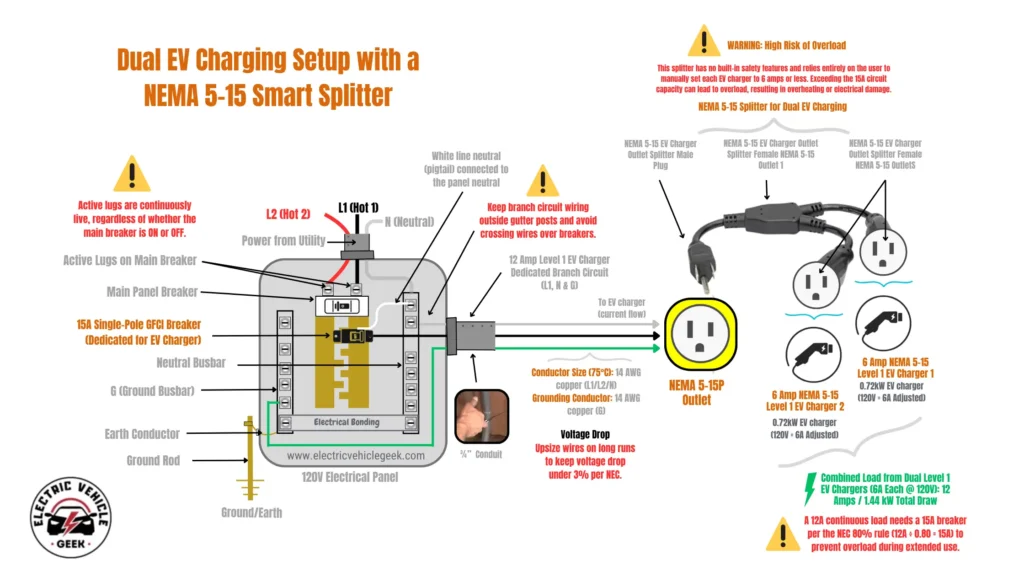
This setup delivered very slow charging speeds: 2 miles of range per hour per vehicle, with no margin for any additional devices on the same circuit.
We found that a better EV charging experience came from using a single 12-amp Level 1 charger with alternating charging, meaning only one EV was powered at a time. This approach delivered faster charging speeds at 1.4 kW compared to charging both vehicles simultaneously, and it proved to be much safer and more reliable over time.
With this setup, the active charger consistently delivered 3 to 4 miles of range per hour, which was far more practical for daily commuting needs than simultaneous EV charging.
To automate this setup, we installed two NEMA 5-15 Emporia smart plugs with built-in scheduling, one connected to each outlet of the splitter.
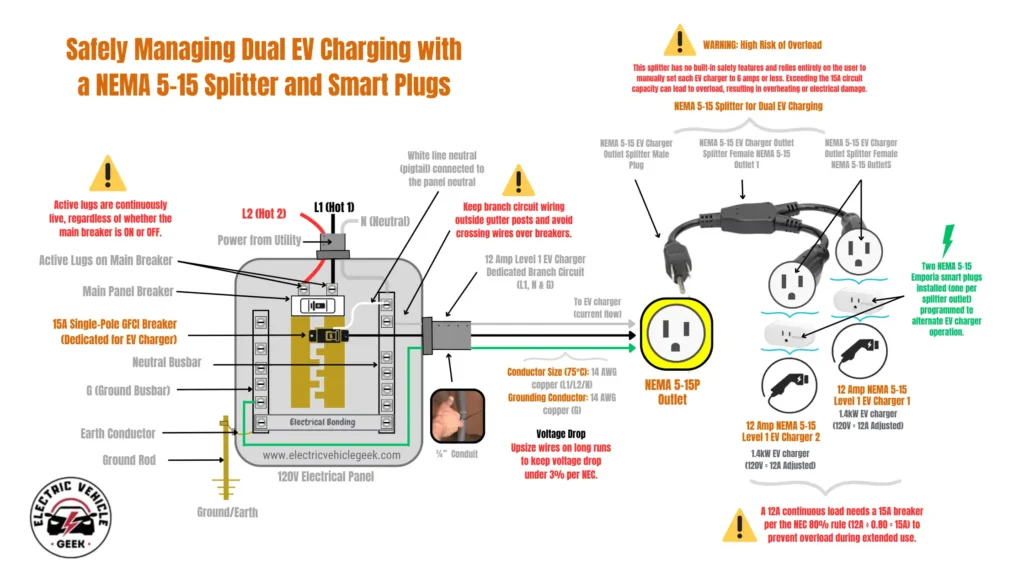
We programmed the plugs to operate at alternating times, ensuring that only one EV charger was active at any given moment. This kept the branch circuit within its continuous load limit and allowed the active charger to deliver a steady 4 to 5 miles of range per hour without overloading the system.
NEMA 5-20R EV Charger Outlet Splitters
NEMA 5-20R EV charger outlet splitters are used with NEMA 5-20R receptacles, which also use a 3-prong plug configuration (hot, neutral, ground) but feature a horizontal neutral blade. A 120V AC, 20-amp EV charger branch circuit typically supplies these outlets.
Using a NEMA 5-20 Outlet Splitter for Level 1 EV Charging
We purchased a NEMA 5-20R outlet splitter rated 20 Amp with 12 12-gauge cord and two NEMA 5-20R female connectors to expand the number of EV chargers in our 120V, NEMA 5-20R EV charger branch circuit for Level 1 EV charging.
We connected a NEMA 5-20R splitter (single male plug) to our EV charger branch circuit’s NEMA 5-20R outlet, which was wired with 12 AWG copper conductors and protected by a dedicated 20-Amp circuit breaker. On each end of the splitter’s female outlets, we plugged in two Level 1 EV chargers, each adjusted to draw 8 Amps. This resulted in a combined continuous load of 16 amps, which falls within the NEC continuous load limit of 80% for a 20-Amp circuit.
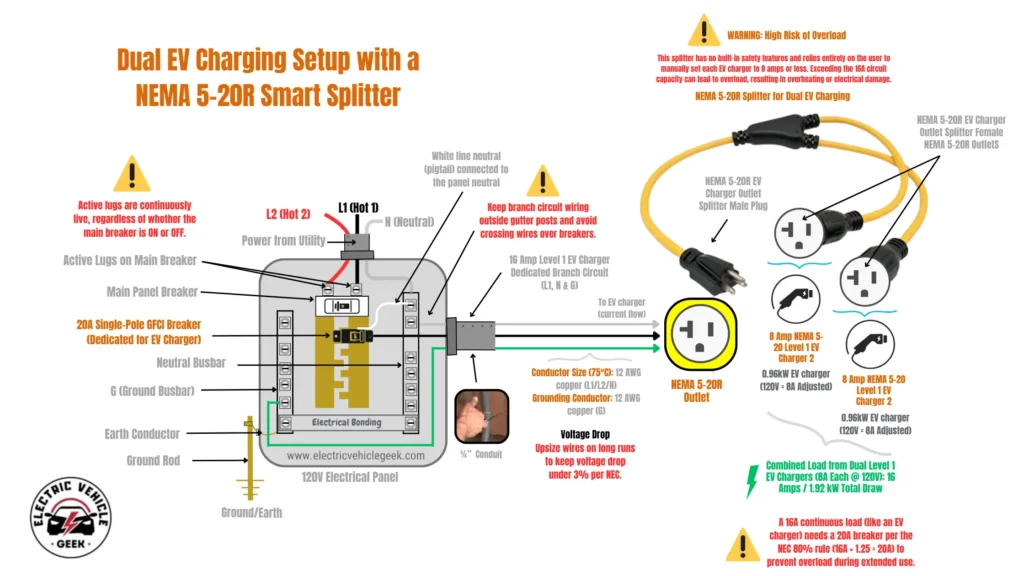
Compared to our NEMA 5-15 simultaneous charging setup, using a NEMA 5-20R outlet splitter provided noticeably better performance; each charger delivered 0.96 kW, or approximately 2.5 to 3.5 miles of range per hour. This level of output is well-suited for overnight charging of plug-in hybrids (PHEVs) or light daily EV use, and works effectively as a reliable trickle charging option. It was a practical improvement over our earlier NEMA 5-15 splitter configuration.
For even better performance, alternating charging on the NEMA 5-20R setup enabled a single Level 1 charger to operate at its full 1.92 kW capacity, adding approximately 5 to 7 miles of range per hour. This method proved far more effective for topping off a primary EV, offering a substantial improvement over alternating charging on a standard NEMA 5-15 splitter.
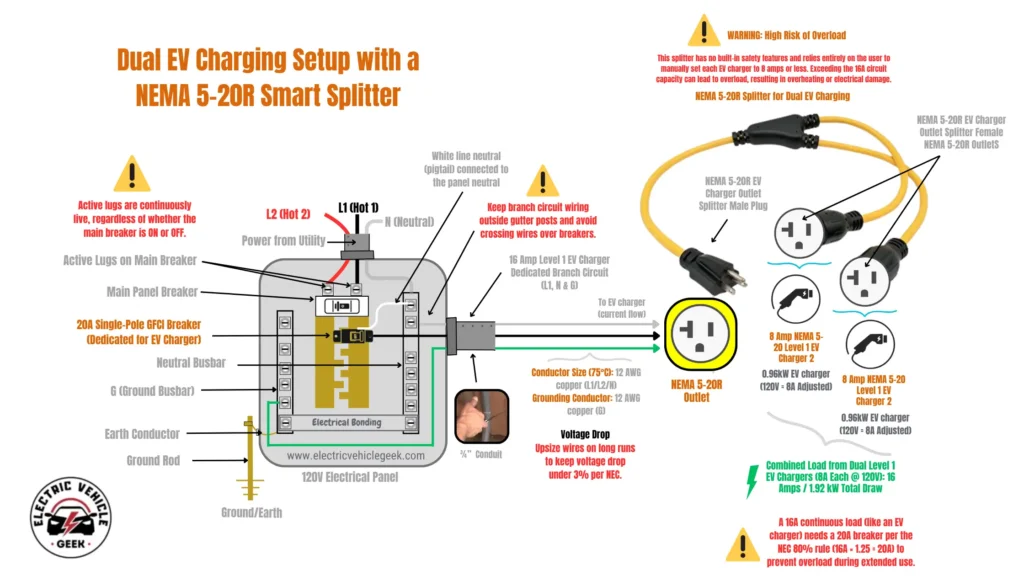
Automating alternating Level 1 EV charging on a 120V NEMA 5-20R branch circuit proved difficult due to the lack of compatible smart plugs or smart outlet splitters. We couldn’t find any reliable 5-20R smart plug options that support scheduling or remote control, making automation nearly impossible at this voltage and plug type.
If you need to alternate charging between two Level 1 EV chargers or devices, we strongly recommend installing a standard NEMA 5-15 outlet instead. This opens up compatibility with a wide range of readily available NEMA 5-15 smart plugs, many of which offer robust scheduling, load monitoring, and remote control features.
Since most Level 1 EV chargers are “dumb” (i.e., lacking built-in smart scheduling), this setup gives you far more flexibility and control over charging cycles, especially useful for households with more than one EV drawing from a shared 15- or 20-amp circuit.
Level 2 EV Charger Outlet Splitters
Level 2 EV charger outlet splitters are designed to plug into a 240-volt receptacle such as a NEMA 10-30, 14-30, or 14-50 on a dedicated EV charging branch circuit. These splitters allow the outlet to be shared between two Level 2 EV chargers or between a Level 2 charger and another high-powered appliance. They work by alternating or regulating power draw to prevent circuit overload.
NEMA 10-30 EV Charger Outlet Splitters
NEMA 10-30 EV charger outlet splitters are used with NEMA 10-30R receptacles, which have a 3-prong configuration consisting of two hot wires and one neutral wire, with no ground wire. A 240V AC, 30-amp EV charger branch circuit typically supplies these outlets.
NEMA 14-30 EV Charger Outlet Splitters
NEMA 14-30 EV charger outlet splitters are designed for use with NEMA 14-30R receptacles, which have a 4-prong configuration consisting of two hots, one neutral, and one ground. A 240V AC, 30-amp EV charger branch circuit typically supplies these outlets.
NEMA 14-50 EV Charger Outlet Splitters
NEMA 14-50 EV charger outlet splitters are used with NEMA 14-50R receptacles, which feature a 4-prong configuration with two hot wires, one neutral wire, and one ground wire. A 240V AC, 50-amp EV charger branch circuit typically supplies these outlets.
NEMA 6-50 EV Charger Outlet Splitters
NEMA 6-50 EV charger outlet splitters are used with NEMA 6-50R receptacles, which have a 3-prong configuration consisting of two hots and one ground, with no neutral. A 240V AC, 50-amp EV charger branch circuit typically supplies these outlets.
Can an RV Splitter/Y-splitter Safely Support EV Charging?
Yes, using an RV splitter or Y-splitter to charge an electric vehicle is technically possible, but only under very controlled and limited conditions.
While it’s technically possible to use an RV splitter or a Y-splitter to power an EV charger, doing so without a deep understanding of circuit behavior, load profiles, and local code compliance can quickly lead to safety issues.
Most RV splitters and conventional Y-splitters are passive devices; they contain no internal load management.
When an NEMA 14-50 RV outlet or a Y-Splitter is plugged into a 240V, 50A NEMA 14-50 outlet, they simply branch the circuit into two receptacles without regulating current. In a garage setting, this can lead to serious safety and performance issues when running two EV chargers simultaneously.
For example, if you connect two Level 2 EV chargers (each drawing 24 amps) to a single 50-amp NEMA 14-50 circuit using a basic splitter, the combined load reaches 48 amps. This exceeds the National Electrical Code’s 80 percent continuous load limit, which allows a maximum of 40 amps on a 50-amp circuit for continuous use. While each charger on its own is safe, running both together puts the circuit into an overload condition, breaker trips, heat buildup at plug terminals, and in some cases, damaged or melted receptacle contacts, particularly during extended overnight charging when the system is left unattended.
Why a Smart EV Charger Splitter Is the Safer, Code-Compliant Choice
Smart EV charger splitters provide a safer, code-compliant way to share a 240V outlet between two devices. They typically include advanced features that enable safe and efficient power distribution, such as:
Load sensing and prioritization logic to detect when one device is drawing current and delay the other accordingly.
Solid-state relays or magnetic contactors to alternate power between outlets without user intervention.
Circuit protection components, like fuses, surge protection, or thermal cutoffs to prevent overheating or overload.
Energy monitoring features to track real-time usage, cost, and performance per outlet for added insight.
All of these systems are built into compact wall tap or cube tap enclosures that offer the physical space, wiring stability, and thermal handling needed to operate under continuous high-current loads. Their form factor also allows for more secure installation near electric vehicle charging stations, making them suitable for long-term use.
In comparison, RV outlet splitters and basic Y-splitters are not designed for this type of electrical demand. They don’t include load management or circuit protection features and are more prone to overloading, tripping, or overheating when both outlets are used at the same time. These types of splitters may work for short-term or low-demand setups, but should not be relied on for EV charging without external safety systems in place.
For reliable and code-compliant charging, it’s best to use a smart EV charger splitter that is purpose-built for the application, meets the requirements of NEC Articles 625, 210, and 750, and uses materials rated for continuous high-power use.
